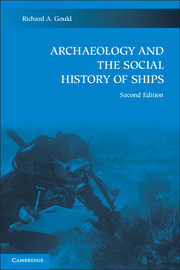Book contents
- Frontmatter
- Contents
- List of figures
- List of tables
- Acknowledgments
- Introduction: Toward a higher standard
- 1 Interpreting the underwater archaeological record
- 2 Underwater archaeology: The state of the art
- 3 Ships and shipwrecks: Basic mechanics
- 4 The archaeology of small watercraft
- 5 The earliest ships
- 6 Shipwrecks and our understanding of ancient trade
- 7 Sailing ships of the Middle Ages
- 8 Ships of the great age of sail
- 9 From sail to steam in maritime commerce
- 10 New technologies and naval warfare
- 11 The archaeology of maritime infrastructure
- 12 The future of shipwreck archaeology
- References cited
- General index
- Ship and site index
1 - Interpreting the underwater archaeological record
Published online by Cambridge University Press: 05 June 2012
- Frontmatter
- Contents
- List of figures
- List of tables
- Acknowledgments
- Introduction: Toward a higher standard
- 1 Interpreting the underwater archaeological record
- 2 Underwater archaeology: The state of the art
- 3 Ships and shipwrecks: Basic mechanics
- 4 The archaeology of small watercraft
- 5 The earliest ships
- 6 Shipwrecks and our understanding of ancient trade
- 7 Sailing ships of the Middle Ages
- 8 Ships of the great age of sail
- 9 From sail to steam in maritime commerce
- 10 New technologies and naval warfare
- 11 The archaeology of maritime infrastructure
- 12 The future of shipwreck archaeology
- References cited
- General index
- Ship and site index
Summary
For experienced divers, the underwater world is a familiar neighborhood. It is as open to human experience as any domain on land. Although strikingly different from the land environment, it is knowable in the same way. The underwater world is as amenable to good scientific controls and methods, and the results can be evaluated by the same standards as archaeology on land. The issues about our understanding of the human past through archaeology are equally relevant underwater and on land. Just as land archaeology had to distance itself from its early connections with tomb-robbers and pot-hunters, underwater archaeology is progressively disengaging itself from its unfortunate association with treasure-hunting. Increasingly, it is characterized by the use of controlled methods of data recovery and by analytical approaches to inferences about past human behavior based on those data.
History and Archaeological Science
Underwater archaeology encompasses a broad range of submerged cultural and historical remains. As a historical science, it is structured by many of the same sorts of assumptions and general principles that guide other historical sciences, like paleontology, evolutionary biology, and geology. Underwater archaeologists, like their land counterparts, rely heavily on scientific methods of dating as well as on controlled laboratory methods for studying ancient diet, technology, and ecology. One of the major questions confronting underwater archaeologists today, however, is the extent to which archaeology should also be viewed as a social science.
- Type
- Chapter
- Information
- Archaeology and the Social History of Ships , pp. 9 - 24Publisher: Cambridge University PressPrint publication year: 2011



